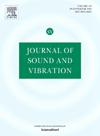A dual-mode hybrid magnetic high-static-low-dynamic stiffness vibration isolator
IF 4.3
2区 工程技术
Q1 ACOUSTICS
引用次数: 0
Abstract
A high-static-low-dynamic stiffness (HSLDS) vibration isolator with both semi-active and passive operating modes is presented. This vibration isolator is designed using three permanent magnets (PMs) and two coil windings (CWs). The HSLDS characteristics arise from the nonlinear repulsive forces between the PMs. The stiffness characteristics of the system can be rapidly adjusted by regulating the current in the CWs. When the current is set to zero, the system transitions from semi-active to passive mode. Unlike traditional vibration isolation systems that utilize linear springs to balance load forces, this proposed system relies on the repulsive forces between PMs, resulting in asymmetric stiffness characteristics. This design ensures a more compact structure while maintaining the HSLDS properties even in passive mode. This paper establishes a nonlinear axial magnetic force model and dynamic equations for the system. Based on Floquet theory, the stability of the nonlinear system is analyzed, and the stability boundaries are identified. The impact of geometric parameters on vibration isolation performance is examined, and optimal parameters are selected to construct the experimental setup. The experimental results validate the vibration isolation performance of the device. Based on the analysis of the experimental data, a semi-active control strategy that incorporates frequency calculations is proposed in this study. Finally, the effectiveness of the semi-active control strategy in enhancing vibration isolation performance is confirmed through additional experiments.
求助全文
约1分钟内获得全文
求助全文
来源期刊

Journal of Sound and Vibration
工程技术-工程:机械
CiteScore
9.10
自引率
10.60%
发文量
551
审稿时长
69 days
期刊介绍:
The Journal of Sound and Vibration (JSV) is an independent journal devoted to the prompt publication of original papers, both theoretical and experimental, that provide new information on any aspect of sound or vibration. There is an emphasis on fundamental work that has potential for practical application.
JSV was founded and operates on the premise that the subject of sound and vibration requires a journal that publishes papers of a high technical standard across the various subdisciplines, thus facilitating awareness of techniques and discoveries in one area that may be applicable in others.
 求助内容:
求助内容: 应助结果提醒方式:
应助结果提醒方式:


